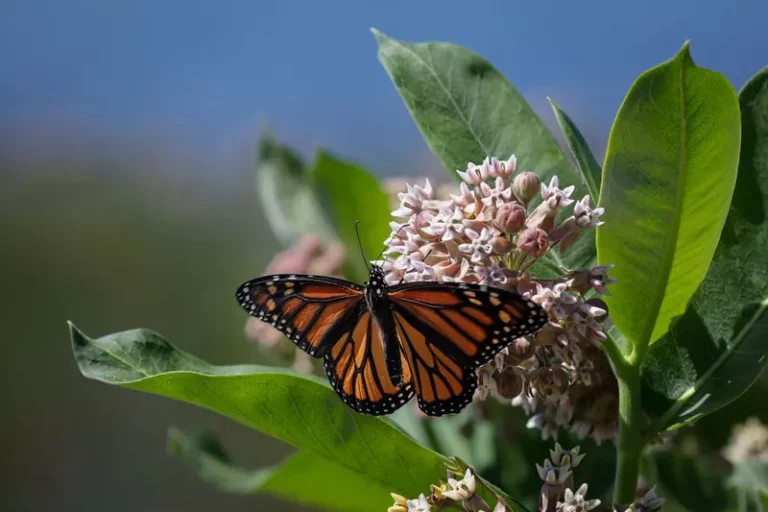The Unsung Hero of the Monarch Migration: Milkweed

The Boston Harbor Islands serve as an important habitat to numerous fascinating organisms, not the least of which is the beautiful Monarch Butterfly (Danaus plexippus). The Monarch Butterfly is the only butterfly species that completes a two-way migration, traveling north and south, back and forth, from Mexico to Canada (1). This migration passes over Boston Harbor every year between mid-summer and fall, and we’re excited to see those bright orange insects landing on our islands in the coming weeks. The Boston Harbor Islands are an important stopover on the Monarch Butterfly migration because they are home to native Milkweed plants (Asclepias sp.), the only food source for Monarch caterpillars (2). But, while this plant plays a pivotal role in the life cycle of these incredible insects, did you know that Milkweed also came to our rescue during World War II?
In the early 1900s, personal floatation devices were made buoyant thanks to a plant-based material called kapok. This cottony material produced by the Kapok Tree (Ceiba pentandra) is lightweight and floats on water—life jackets stuffed with this fluff saved lives whether you fell out of a canoe while fishing or had to abandon a sinking naval vessel. But kapok as a crop was grown on an industrial scale in Asia, and when Japan invaded Asia during World War II, the United States was cut off from this invaluable resource. Enter: the Milkweed plant.
Of the 200 known species of Milkweed, 73 grow in the United States (3). Each species produces fragrant and vibrant flowers that, in late summer, turn into brown pods that encase many seeds. Milkweed seeds are covered in this white, flossy material that is both lightweight and buoyant. When the US lost access to the material needed to create life jackets, a Chicago physician named Dr. Boris Berkman theorized that Milkweed floss would serve as a suitable replacement. In 1942, after extensive testing determined the amount needed and the cost of production, an operations center was set up in northern Michigan to collect and process Milkweed floss. With most of the men out fighting on the frontlines, labor was often performed by youth groups such as the Girl Scouts, the Boy Scouts, and 4-H Clubs with these children being paid 15 cents for each bag they filled. Throughout the war, 1.5 billion Milkweed pods were harvested, enough to fill over a million life jackets and flight suits (4).
These floatation devices were likely used by soldiers stationed at forts around Boston Harbor, like Fort Andrews on Peddocks Island and Fort Warren on Georges Island. These soldiers were surrounded by water, after all. Once the war was over, both the Boston Harbor forts and the Milkweed life jackets were decommissioned, with advanced technology rendering these wartime features obsolete. Yet the Milkweed plant still serves an important role out here on the islands as food and nesting grounds for the Monarch Butterfly today. As the migration season starts to get underway, we honor the Milkweed for bringing us this wonderous biological event and for bringing our troops home safely.
Footnotes
(1) “Monarch Butterflies,” The Nature Conservancy.
(2) “Why Milkweed?”, Save Our Monarchs.
(3) “Milkweed Regions & Seed Needs,” Monarch Watch.
(4) Albert, “Petoskey, Michigan and Milkweed.”
References
Albert, Kaitlyn. “Petoskey, Michigan and Milkweed: An unsuspected plant aided in the War effort during World War Two.” Little Traverse Historical Museum. 2022. https://www.petoskeymuseum.org/milkweed.html.
Kim, Yehyun. A monarch butterfly on common milkweed. Photograph, Friends of Acadia. U.S. National Park Service. 2023. https://www.nps.gov/articles/000/milkweed-and-monarchs.htm.
Monarch Watch. “Milkweed Regions & Seed Needs.” Bring Back the Monarchs. 2023. https://monarchwatch.org/bring-back-the-monarchs/milkweed/milkweed-regions-seed-needs.
The Nature Conservancy. “Monarch Butterflies Bring Together Conservation and Culture Between U.S. and Mexico.” The Nature Conservancy. September 6, 2021. https://www.nature.org/en-us/what-we-do/our-priorities/tackle-climate-change/climate-change-stories/monarch-butterflies-us-mexico.
Save Our Monarchs Foundation. “Why Milkweed? Monarchs Need Milkweed.” Save Our Monarchs. 2015. https://www.saveourmonarchs.org/why-milkweed.html.